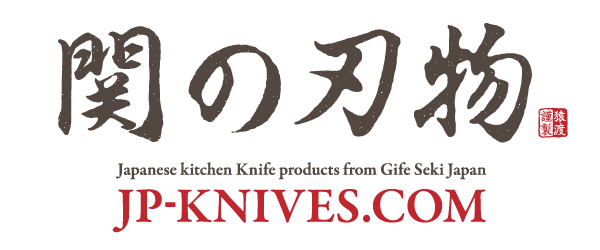Chef's Knife (a.k.a. Gyuto) - the classic professional knife

The traditional Western chef's knife is a long, broad, multipurpose knife. In Japan, it is called a 'gyuto', meaning 'beef knife', in reference to the design's original use. Today, it is used not only to cut and disjoint meat but also to chop vegetables, mince herbs, and perform a number of other tasks. The blade of the chef's knife is curved, either all along its length (German style) or more towards the tip (French style). This makes it particularly suited to a rocking style of cut. Japanese-made chef's knives are considered to be among the best in the world, thanks to a combination of top quality materials and superior workmanship.
Santoku - the original Japanese kitchen knife

The santoku, a popular and distinctively Japanese kitchen knife, is another all-rounder; its name in fact means 'three uses', because it can be used for vegetables, fish and meat. Developed by Japanese knife-makers as an alternative to the Western chef's knife or gyuto, the santoku has a few distinguishing features. Firstly, the gyuto's sharp point is replaced by a 'sheep's foot' tip, where the top or 'backstrap' of the blade curves sharply downward to meet a more gently curved cutting edge. This profile makes the santoku more suited to a pushing style of cut, which is traditional in Japanese cuisine. Secondly, the santoku's blade is lighter, thinner and slightly shorter than that of the gyuto. Being thinner, it often has to be made from harder materials. As a general rule, this means the blade keep a sharper edge, but is slightly more brittle. One should therefore avoid using a santoku to cut through bone or very hard ingredients such as squash.
Deba (a.k.a. Deba-Bocho) - the fish carver

The deba-bocho is a pointed carving knife originally used for beheading and filleting fish, for which task its thick, curved blade is ideally suited. The deba can also be used for cutting meat, although it is generally considered too thick for slicing vegetables. For a Japanese chef dealing with whole fish, the deba is an indispensable knife.
Nakiri (a.k.a. Nakiri-Bocho) - the Japanese vegetable knife

The nakiri-bocho is a square-tipped Japanese knife designed especially for cutting vegetables. Its completely flat, thin blade allows the user to slice delicate ingredients neatly without crushing them. Since there is no curve to the blade, it naturally suits a straight, pushing cut. It is an excellent household vegetable knife, although care should be taken not to use it on very hard ingredients.
Utility Knife (a.k.a. Petty Knife) - a handy small knife, perfect for quick tasks

The petty knife is a Japanese style of utility knife. It is ideally suited to precision tasks such as peeling fruits and vegetables. Unlike shorter and stubbier paring knives, a Japanese utility knife can also be used comfortably on a chopping board, thanks to its taller heel and longer blade. The petty knife comes into its own wherever space is limited or a larger knife feels too unwieldy. Use it for deboning chicken, preparing garnishes or slicing cakes, fruits and cheeses.
Sashimi Knife (a.k.a. Sashimi-Bocho or Yanagiba) - a quintessentially Japanese knife

The sashimi knife is designed exclusively for slicing fish. It is very long, thin and sometimes flexible. Given the importance of fish in Japanese cuisine, it is perhaps unsurprising that there exist many subcategories of sashimi knife. The 'fugu-hiki' and 'tako-hiki', for example, are traditionally used only for slicing pufferfish and octopus, respectively. It is instructive to note that the '-hiki' suffix in these names comes from the verb 'to pull'. Indeed, the correct technique when using any sashimi knife is to draw the blade toward oneself, rather than pushing away or sawing back and forth. Many sashimi knives are 'single bevel' or 'chisel ground' to enable precision slicing, which is why they are supplied in left-handed and right-handed versions.
Chinese Chef's Knife - a tough and versatile kitchen knife

Although it resembles a Western meat cleaver, the Chinese chef's knife is actually a very versatile tool. Many professional chefs are beginning to recognize the convenience of this broad, flat blade for chopping, mincing, crushing and scooping up a variety of ingredients. In Chinese cuisine, of course, this type of kitchen knife is usually the main or only cutting tool used.
Recommends
- Chef's Knife (a.k.a. Gyuto) - the classic professional knife
- Santoku - the original Japanese kitchen knife
- Deba (a.k.a. Deba-Bocho) - the fish carver
- Nakiri (a.k.a. Nakiri-Bocho) - the Japanese vegetable knife
- Utility Knife (a.k.a. Petty Knife) - a handy small knife, perfect for quick tasks
- Sashimi Knife (a.k.a. Sashimi-Bocho or Yanagiba) - a quintessentially Japanese knife
- Chinese Chef's Knife - a tough and versatile kitchen knife
